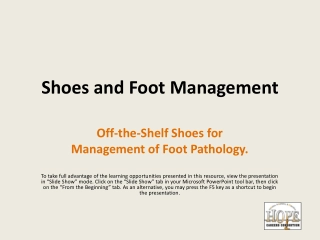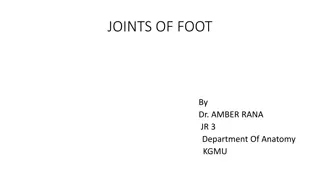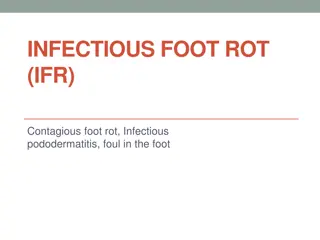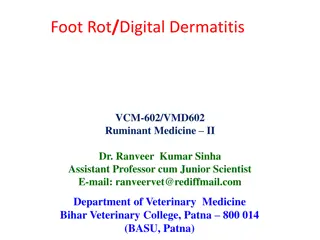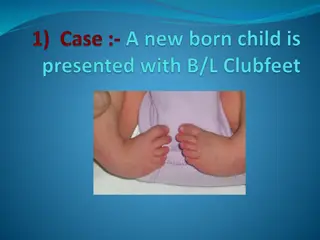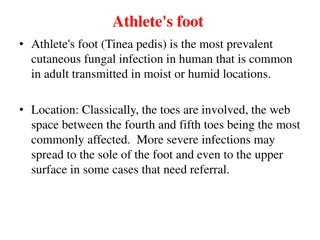Understanding the Diabetic Foot: Stages, Assessment, and Management
Explore the natural history of the diabetic foot, from initial stages to potential complications like ulcers and infections. Learn about the assessment of ulcerated feet, including identifying signs of infection and necrosis. Discover the role of radiography and microbiological control in managing diabetic foot issues effectively.
Download Presentation

Please find below an Image/Link to download the presentation.
The content on the website is provided AS IS for your information and personal use only. It may not be sold, licensed, or shared on other websites without obtaining consent from the author. Download presentation by click this link. If you encounter any issues during the download, it is possible that the publisher has removed the file from their server.
E N D
Presentation Transcript
Diabetic foot Dr. Mahshid Talebi-Taher, MD, ID. Infectious Diseases Department IUMS
The natural history of the diabetic foot can be divided: Stage 1: Normal foot Stage 2: High-risk foot Stage 3: Ulcerated foot Stage 4: Infected foot Stage 5: Necrotic foot Stage 6: Unsalvageable foot
Patients in stages 1 and 2 can be seen in primary care. Patients in stages 3 5 are best seen in the multidisciplinary diabetic foot clinic.
The ulcerated foot: Site Size Appearance of the ulcer and surrounding tissues Discharge Oedema Tenderness Smell Probe-ability .
Moist green or yellow slough indicates infection. Black tissue indicates necrosis Diffuse redness of the surrounding tissues may indicate infection in both neuropathic and neuroischaemic feet, especially if this is associated with swelling and purulent discharge.
A purplish colour indicates reduced oxygen supply to the tissues, which may result from ischaemia or severe infection or both. Purulent discharge is indicative of infection. Increased amounts of clear discharge may be an early indication of infection.
Any smell associated with an ulcer is suggestive of infection. Oedema around an ulcer is usually suggestive of infection but may be related to ischaemia
Radiography: 1. foreign body 2. clinical signs of infection 3. unexplained pain or swelling 4. the ulcer has been present for longer than 1 month.
Microbiological control: Bacterial growth in ulcers impedes the wound healing rate. If the bacterial burden increases there will be bacterial imbalance which may show itself as increased exudate before frank infection develops. The crucial problem is when to intervene with antibiotics.
Study: patients with diabetes and clean ulcers associated with peripheral vascular disease and positive ulcer swabs should be considered for early antibiotic treatment. All swabs taken from diabetic foot ulcers should be deep swabs taken after debridement has been carried out.
curettings and tissue from the base of the ulcer may be a more acceptable microbiological sample compared with the deep ulcer swab.
Cephalexin Cloxacillin Clindamycin Cotrimoxazole Quinolones
Stage 4 the infected foot: Is t possible that so short a time Can alter the condition of a man? infection can destroy their foot and ruin their life in a remarkably short time. polymicrobial organisms associated with deep wound infections.
Localized infection Spreading infection Severe infection
Localized infection Pain Base of the ulcer changes from healthy pink granulations to yellowish or grey tissue Increased friability of granulation tissue Increased amount of exudate Exudate changes from clear to purulent Unpleasant smell Sinuses develop in an ulcer
Case study: A 77-year-old man with type 2 diabetes of 22 years duration, and peripheral vascular disease complained of pain
A deep swab was sent for culture and the abscess cavity was irrigated with normal saline and dressed; Clindamycin were prescribed wound swab grew Staphylococcus aureus and Streptococcus group B. The toe healed in 1 month
When the ulcer extends deeply to fascia or tendon: Ciprofloxacin+clindamycin
Key points Pain may be the sole manifestation of infection in the diabetic neuroischaemic foot. Infection in the neuroischaemic foot may not be associated with swelling.
CASE STUDY A 35-year-old woman with type 2 diabetes of 10 years duration treated with insulin, and severe neuropathy presented unwell with nausea and shivering.
She was admitted to hospital and given intravenous ceftazidime 1 g tds+clindamycin. Ulcer swab grew Staphylococcus aureus and Streptococcus group B Cloxacillin continued. Infection resolved within 5 days, and she was discharged for follow-up in the diabetic foot clinic.
Key points Lymphangitis is an important sign of spreading sepsis There may be no pyrexia and no pain in cases of spreading infection of the diabetic foot
Ciprofloxacin and clindamycin Piperacillin/tazobactam Meropenem Imipenem Tigecyline
Severe infection This refers to ulcers with extensive deep soft tissue infection and also infected feet with blue or purple discolouration of tissues. This stage may also be associated with septicaemia, with the patient presenting with hypotension and organ failure.
These people need intravenous antibiotics, immediate hospital admission and an urgent surgical opinion regarding the necessity of surgical drainage. Palpation may reveal fluctuance, suggesting abscess formation.
Purple blebs may indicate subcutaneous necrosis. when a fever is present it usually indicates a severe infection, and the deep spaces of the foot are usually involved with tissue necrosis, severe cellulitis and possible bacteraemia
Severe infections are often polymicrobial and both Gram-positive and Gram- negative organisms are present together with anaerobes.
Severe subcutaneous infection by Gram- negative and anaerobic organisms produces gas, which may be detected by palpating crepitus on the lower limb and can be seen on X-ray. The presence of gas does not automatically mean that the classical gas gangrene organism Clostridium perfringens is present.
CASE STUDY A 50-year-old man with type 1 diabetes for 30 years and a renal transplant, suffered a spontaneous rupture of his Achilles tendon and was treated in another hospital in a plaster cast. He noted staining from discharge within the cast and came up to the diabetic foot clinic. The cast was removed,
He was admitted for intravenous antibiotics, clindamycin+ceftazidime 1 g tds. The deep wound swab grew Staphylococcus aureus and the antibiotics were reduced cloxacillin.
Case study: Puncture wound in immunocompromised patient.
Key points Diabetic patients are immunosuppressed and do not respond appropriately to infection. This is exacerbated when the patient has other autoimmune diseases or is on immunosuppressant therapy. Diabetic patients with foot infections in such circumstances demand very close surveillance.
Osteomyelitis X.Ray MRI Bone BX.
Fusiform swelling (sausage toe) and erythema are frequently associated with osteomyelitis and X-rays are needed to confirm the extent of the infection in the bone and monitor progress.
Case study: Small collection of fluid between the extensor hallucis longus tendon and the metatarsophalangeal joint/proximal phalanx of the big toe.
an empirical regimewith good bone penetration should be given such as Clindamycin 600 mg tds and ciprofloxacin 500 mg bd. Antibiotics should be given for at least 12 weeks. if the infected bone is resected then a shorter course of antibiotics such as 4 weeks may be necessary.
MANAGEMENT OF INFECTION: Which antibiotics should be prescribed? Will antibiotics alone control the infection or will surgery also be necessary?
Principles of antibiotic treatment: Infection can be caused by Gram-positive aerobic, and Gram-negative aerobic and anaerobic bacteria, singly or in combination. When Gram negative bacteria are isolated from a deep ulcer swab or curettings they should not, therefore, be regarded as automatically insignificant.
at initial presentation it is important to prescribe a wide spectrum of antibiotics for three reasons: Rapid progression MO? diabetic patients are immunosuppressed(As Louis Pasteur said: The germ is nothing. It is the terrain in which it grows that is everything ).
The route by which therapy is given will depend on the severity of the infection. oral therapy for localized infections, intramuscular or intravenous therapy for spreading infections and intravenous therapy for severe infections. Intestinal absorption is unreliable in these circumstances
Antibiotics used mainly against Gram-positive organisms: Amoxicillin Cloxacillin Co-amoxiclav Clarithromycin-clindamycin Doxycycline Rifampin(should not be given alone because resistance can develop rapidly).
cotrimoxazole Vancomycin Teicoplanin Linezolid(It should not be given for more than 28 days).
Antibiotics used mainly against Gram-negative organisms: Ciprofloxacin Ceph 3,4 Ag
Indications for surgery A large area of infected sloughy tissue Localized fluctuance and expression of pus Crepitus with gas in the soft tissues on X- ray Blue or purplish discolouration of the skin.


